Occult metal blog Praefuscus Ferrum published the first issue of Protervitas Zine onto the Internet Archive.
32 CommentsTags: brett stevens, occult, praefuscus ferrum, webzine, zine, zines
Occult metal blog Praefuscus Ferrum published the first issue of Protervitas Zine onto the Internet Archive.
32 CommentsTags: brett stevens, occult, praefuscus ferrum, webzine, zine, zines
A new issue of the legendary Isten fanzine is being published later this year by Svart Records. Those foresighted enough to have purchased the Isten Fanzine: Don’t Break the Ghost compilation book will know how big of a deal this is. Isten was one of the most legendary death and black zines along with Metalion’s Slayer.
18 CommentsTags: books, fanzines, Finland, isten, metal zines, svart records, upcoming release
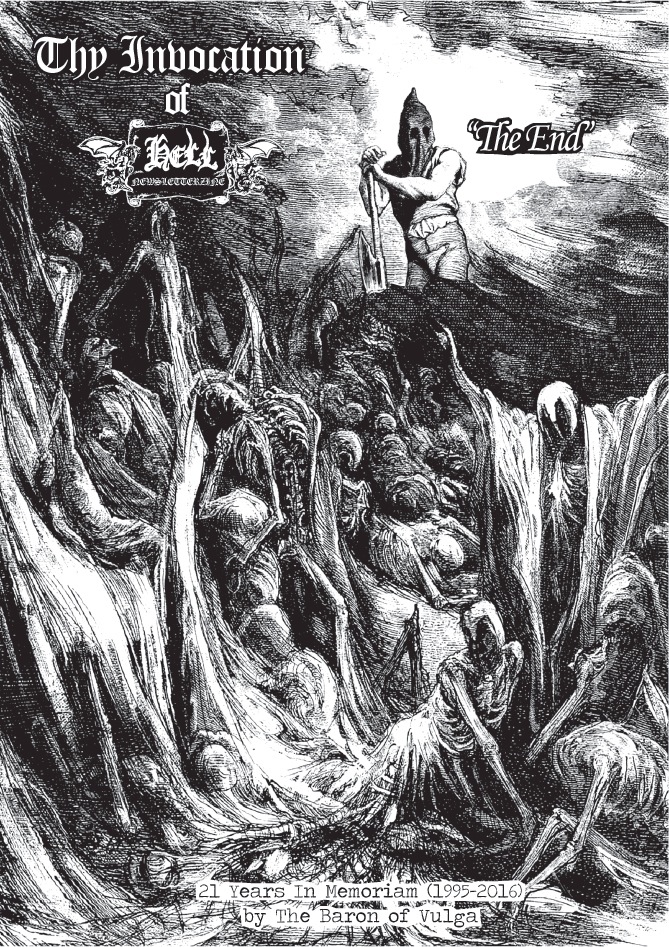
Thy Invocation of Hell zine 21st anniversary reprint from Afterlife Productions is available in the United States from vinyl specialist distro Analog Worship. The zine is packed with interviews conducted in the early, formative days of legends like Beherit, Blasphemy, Varathron, Immortal, and Emperor. Afterlife Productions themselves are down to their last 30 copies for those close to Malaysia.
No CommentsTags: afterlife productions, analog worship, Black Metal, book, metal zine, news, thy invocation of hell, underground zines, zine

Malaysian label Afterlife Productions has restored and reprinted Southeast Asia’s first black metal zine, Thy Invocation of Hell. It’s packed with interviews from tons of legendary bands, all conducted in their early and formative years, before wannabe rockstar egos and commercialism took hold. Buy it. From the label’s Facebook page:
3 CommentsTags: 1995, afterlife productions, Asia, Black Metal, Interviews, malaysia, reissue, repress, thy invocation of hell, underground zines, zine, zines

Afterlife Productions has recently released the latest issue of Deadhead Fanzine. This Malaysian label (calling themselves “Asia’s last stand for conservative metal literature”) has compiled an substantial quantity of metal literature into a package that’s apparently more like a paperback book than a simple magazine. Besides the usual reviews, articles, and etc, the major selling point is likely the dozens of included interviews with both well known and more underground metal bands. Morbid Angel headlines, with former members Mike Browning and Richard Brunelle talking about the band’s earliest days, and the latter also makes his way to the front cover. Deadhead Fanzine 6.66 also understandably devotes some space to Malaysian underground metal in particular, featuring interviews with bands from all over the country. The sheer quantity of content here could make it a very tempting purchase, and it is available from Afterlife’s website.
Tags: afterlife productions, deadhead fanzine, fanzines, Interviews, malaysia, metal zine, mike browning, morbid angel
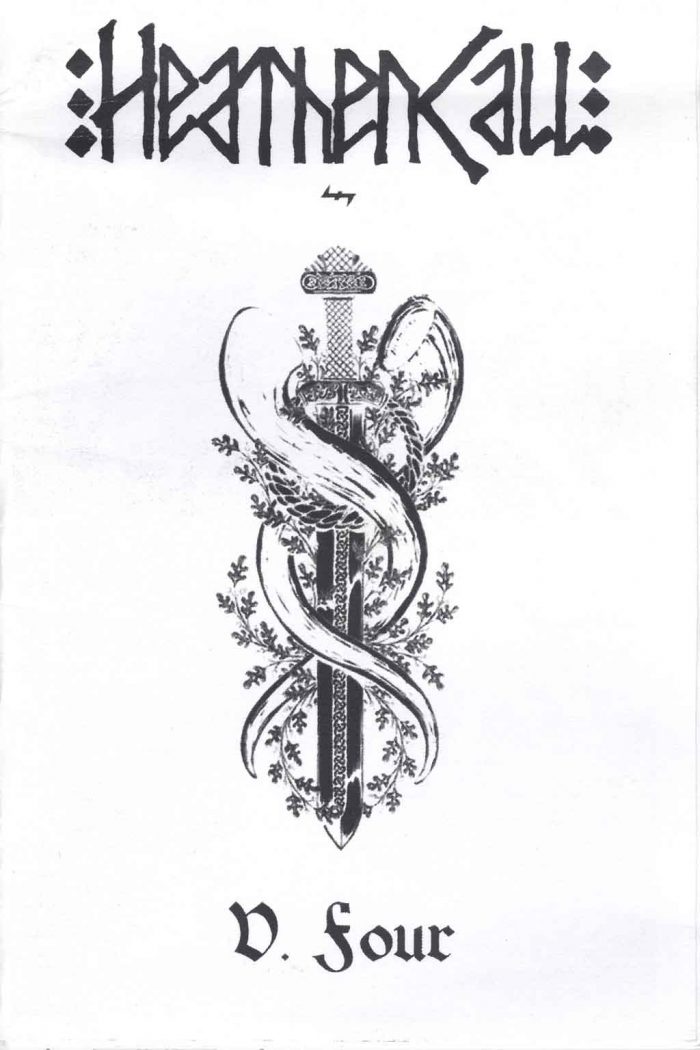
In the early 1990s, before Wikipedia and Metal-Archives destroyed knowledge by standardizing it, zine editors were like guerrilla truth-fighters. At their day jobs, they stood in front of copiers while a colleague nervously kept watch, running off thousands of sheets that they then stayed up until dawn stapling and preparing for mailing. Everyone who could be a fanatic took his or her turn firing off publications.
Heathen Call comes from that same spirit. Its goal is to write about heathen music, which is the intersection of folk and metal with sometimes ambient/soundtrack overtones that focuses on pagan/ancient topics and aesthetics. If the medievalism of Dead Can Dance or the Ren Faire seemed like fun, but with the vicious realist approach of metal, that would be the heathen underground. In this issue, Heathen Call covers long-running folk band Changes, black/folk metal band Gjhallarhorn from Ukraine, heavy metal band Akashah, and black metal band Grafvolluth. While this slants the content by weight toward the metal, the most interesting part is the Robert N. Taylor interview with Changes in which he discusses the challenges of staying realistic in a world dedicated to frivolous distraction to avoid seeing its inner emptiness. Changes formed in 1969 and in theory would have been included in the great folk music explosion, but they did not fit in with the flowers in the hair message of the age. Taylor brings forth not only forgotten history but more fully developed ideas on pagan, heathen and traditional culture than one normally hears.
This zine is spectacularly short and clean. The focus is clearly the content. With elegant but sparse graphics, black-on-white layouts designed for easy reading, and selective content of interviews with questions that get into the depth of purpose and motivation behind these artists, Heathen Call would not fit in with the “what amps do you use?” and “have there been many groupies this tour?” type writing that populist magazines aim for, nor the political dogma zombie recitation of the political magazines. As such, this is a rare animal. It would be interesting to see more interviews with people such as Robert N. Taylor and other thinkers in this area, and getting away from the also-ran black metal bands who are exploring a heathen area tangentially to being participants in the dead, bloated and off-gassing black metal scene, but as a content-based zine Heathen Call provides an interesting, quality read for those interested in this niche spanning multiple genres.
4 CommentsTags: akashah, changes, gjallarhorn, grafvolluth, heathen call, robert n. taylor, zine

1. Overview
2. Corpophilia and Necrobiosis
3. Necropsy
4. Rippikoulu
Written by Devamitra
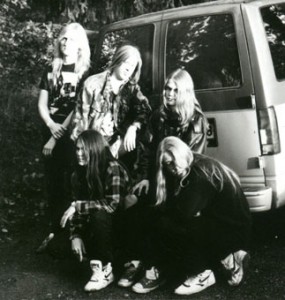 Midsummer’s sylvan possession will claim many lives tonight by drowning, stabbing, hanging and other morbid rituals that cloud the light of the greatest Finnish celebration. It can be said that the spiritual conflict between the barrenness of the Finnish urban life and the sudden plunge into the freshness of nature undertaken by most at this time of the year, combined with the gargantuan intake of alcohol, causes a temporary collapse of the veil of the civilization, when festivals end as festivals must. Under the deceptive tolerance of the society, dark depths boil and murderous impulses become sublimated thoughts. Some of these undercurrents were illuminated and analyzed almost as topics of transcendental philosophy in the dark contemplative statements of Finnish Death Metal, one of the strongest musical movements that ever arose from Finnish soil and also unarguably one of the strongest Death Metal scenes of the period. It is a testament to creativity that it’s still very hard to pin down a certain easily recognizable ‘Finnish sound’, but this does not mean a lack of mental images connecting them.
Midsummer’s sylvan possession will claim many lives tonight by drowning, stabbing, hanging and other morbid rituals that cloud the light of the greatest Finnish celebration. It can be said that the spiritual conflict between the barrenness of the Finnish urban life and the sudden plunge into the freshness of nature undertaken by most at this time of the year, combined with the gargantuan intake of alcohol, causes a temporary collapse of the veil of the civilization, when festivals end as festivals must. Under the deceptive tolerance of the society, dark depths boil and murderous impulses become sublimated thoughts. Some of these undercurrents were illuminated and analyzed almost as topics of transcendental philosophy in the dark contemplative statements of Finnish Death Metal, one of the strongest musical movements that ever arose from Finnish soil and also unarguably one of the strongest Death Metal scenes of the period. It is a testament to creativity that it’s still very hard to pin down a certain easily recognizable ‘Finnish sound’, but this does not mean a lack of mental images connecting them.
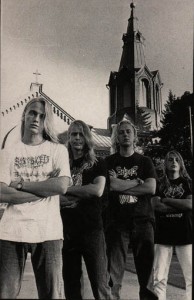
Among the first were the playful Death Metal / Grindcore crossover Xysma, the brutal Disgrace and the dreamier but less eloquent Funebre from the historic capital of Turku. In nearby Loimaa the discipline of Demigod and Adramelech formulated occult and mythological visions from these roots. The true monument of the early scene was created by Abhorrence from the modern capital of Helsinki, in their devastating demos that displayed the ferocity of old school black metal alongside articulate influences from British and Swedish Death Metal movements. Later the heritage of Abhorrence spawned into the more ‘professional’ folk influenced narratives of Amorphis des
pite the fact that the earlier band was far from amateurish itself. Besides Xysma, also bands from the wooded Birkaland county were heavily influenced by punk and thrash especially in anti-authoritarian spirit: Rippikoulu, Convulse, Purtenance and Lubricant. A counterpart were the quasi-Byronian melancholic poets of Ostrobothnia, heirs of the strict religious sects of the Bothnian coast: Sentenced, Cartilage and Wings. The same mystical traits combined with grindcore, Sarcofago and lots of booze in Beherit, Belial (“Wisdom of Darkness”) and Impaled Nazarene, who composed the classics of Finnish Black Metal contemporaneously (not successively as in the world at large) to the Death Metal movement. The promising Necropsy from Lahti released a strong split album ‘Unholy Domain’ with Demigod but never managed to release a full-length album back in the day, while the cryptic and absolutely unique one album wonder Demilich from thrash capital Kuopio set the bar for Finnish ‘progressive’ Death Metal extremely high on ‘Nespithe’; only Unholy from Imatra or Paraxism from Jyväskylä (who did not release an album) could compete in sublime weirdness. Mordicus from North Karelia also left a legacy of one quality album, ‘Dances from Left’, while fellow Joensuu mystics Phlegethon only released demos and one EP before some of the same individuals surfaced in the Doomdeath tribute band Hooded Menace. The quest to bring back moments of old school Death Metal majesty brought about by later bands such as Devilry, Slugathor, Deathspawned Destroyer, Ascended and Lie in Ruins is discussed in more detail in our article “Ascension of Sepulchral Echoes: A Finnish Death Metal Revival”.
We are proud to present a sequence of tracks collected by Fenno-American Death Metal connoisseur Benjamin Tianen in tribute to Finland and its strain of artists and conjurers. This compilation of obscure quality Finnish Death Metal is recommended for listening in the twilit hours of day, preferably in rather uninhabited locations as most of Finland is. If there is one teaching one must bring home from Finnish artists and Finnish school of mental exploration, it is that one must not love happiness as much as one loves truth.
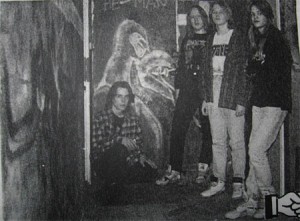 Visitors remembers the Western shores of Finland mostly from their warm summer days, windstorms and chilly nights of Autumn. The dunes of the shore of Yyteriare unique in the whole Scandinavian region while most of the towns carry relics of past industries but have failed to establish themselves in modern or digital age, remaining secluded communities with little vital attractions to the youngsters. Thus it is not surprising that towns such as the historic Uusikaupunki, a weird silent nature-surrounded industrial port that has always baffled my spirit, gave birth to multiple demo level death metal insanities in the early 90′s.
Visitors remembers the Western shores of Finland mostly from their warm summer days, windstorms and chilly nights of Autumn. The dunes of the shore of Yyteriare unique in the whole Scandinavian region while most of the towns carry relics of past industries but have failed to establish themselves in modern or digital age, remaining secluded communities with little vital attractions to the youngsters. Thus it is not surprising that towns such as the historic Uusikaupunki, a weird silent nature-surrounded industrial port that has always baffled my spirit, gave birth to multiple demo level death metal insanities in the early 90′s.
Coprophilia described the twisted and tangled nature of woods, human remains and animal entrails on the four songs of their one and only demo, playing distinctive and intricate heavy metal influenced straightforward melodies to lend catchiness to songs that in their spontaneous clarity bring into focus the main influences for old Finnish death metal: heavy metal, Bay Area speed metal, horror music and UK bands in the vein of Napalm Death.
http://www.youtube.com/watch?v=OAqI9V0cUtY&feature=player_embedded
More sarcastic, irritant and grinding, Necrobiosis pummeled a simplistic punk-o-rama riffspace almost like Blasphemy or Archgoat would have done it except using the concluding expectancy common to dual vocal grindcore so that the grunts and screams echo exactly the phrases played by the rhythm guitar. Lead guitars often recall metal guitarists’ introductory practice pieces in the vein of Iron Maiden and Rainbow, as was the case with not only Coprophilia, but also Amorphis, Sentenced and many other greats. Curiously for a word I had never heard before, Necrobiosis was also picked as the band name around the same time by guys a couple of hundred kilometers away in Riihimäki. You might know this band better by a name they thought of later: Skepticism.
http://www.youtube.com/watch?v=-v_wYJOfJFM&feature=player_embedded
In an era when Finnish death metal was a freaky force of nature, punishing everything in its path, Necropsy from Lahti, Finland, was doomed to obscurity as many of their peers, the likes of Mordicus, Convulse, Funebre and Abhorrence. In five years (1989-1993) they created 7 demo tapes and appeared on one 7″EP and a split LP with Demigod on the infamous Seraphic Decay label. Thrashing and grinding, organic and brutalous death metal of this kind would freshen up the scene of today immensely and thus we welcome the rumours that Necropsy is staging a comeback in true old school spirit to show the weakened versions of Carcasses and Pestilences who still holds the true spirit of unholy death.
http://www.youtube.com/watch?v=RfxdKxkg-Ao&feature=player_embedded
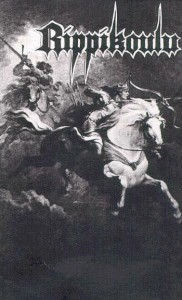 What force in the inner core of man gives birth to death metal impulse? Is it fear, hatred, obstinence, passion, paranoia, vision or celebration of power? “Rippikoulu” is Finnish for “confirmation school”, which is an institution partaken by Finnish teenagers in order to be educated in the rituals and tenets of the Lutheran church. Celebrated usually in a camp away from the city and the participants’ homes, it ironically has a habit of devolving into a minor orgy of sin while the sole motivation of attendance for most is the hope of the meager sums of money elderly relatives usually bestow upon one, after the confirmation. When small town death metal cults produced their blasphemic demo output, it’s not far-fetched to say that it was this kind of absurd experiences with organized religion that led them to deny and spontaneously analyze the hypocritical, indoctrinating social customs that lead a child or a man to accept Christ for the sake of community and convenience, while at the same time materialistically mocking the values of the spiritual tradition.
What force in the inner core of man gives birth to death metal impulse? Is it fear, hatred, obstinence, passion, paranoia, vision or celebration of power? “Rippikoulu” is Finnish for “confirmation school”, which is an institution partaken by Finnish teenagers in order to be educated in the rituals and tenets of the Lutheran church. Celebrated usually in a camp away from the city and the participants’ homes, it ironically has a habit of devolving into a minor orgy of sin while the sole motivation of attendance for most is the hope of the meager sums of money elderly relatives usually bestow upon one, after the confirmation. When small town death metal cults produced their blasphemic demo output, it’s not far-fetched to say that it was this kind of absurd experiences with organized religion that led them to deny and spontaneously analyze the hypocritical, indoctrinating social customs that lead a child or a man to accept Christ for the sake of community and convenience, while at the same time materialistically mocking the values of the spiritual tradition.
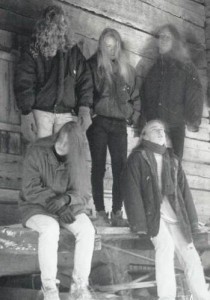 Valkeakoski was another boring town even by Finnish standards which used to smell like feces because of the paper industry, an example of climate perfect for original death metal. At surface, the most notable characteristic of Rippikoulu was their use of Finnish language for invocation, which has often been abused but at the right hands and in the right mouth withholds the tremendous syllabic power feared by Nordic warriors since the Bronze Age, as recounted in Kalevalan mythos. The stupendous music of Rippikoulu’s two demos, “Mutaation Aiheuttama Sisäinen Mätäneminen” (“internal rotting by mutation”) and “Musta Seremonia” (“black ceremony”), bridge the grindcore influenced ecstatic physicality of Xysma with earthen, suffocated sludge in contorted, space-and-time stretching rhythmic dynamicism reminiscent of Winter‘s and diSEMBOWELMENT‘s most psychedelic lapses. It gives the impression of a blind, tormented prophet shouting fragmented glimpses of pure vision to the darkened, apocalyptic world with barely any ears left to listen to human voice amidst the collapse of industrial infrastructure. In the slow, emotional leads one could hear Paradise Lost, but in its warlike sparseness and logic, even nihilism, it’s something closer to the most doomed moments of Bolt Thrower’s “War Master” while the almost ridiculously disembodied parody of gloomy gothic organ in “Musta Seremonia” brings to mind Unholy‘s drugged haze; Faustian sorrow and blasphemous sense of humor united in one single strangely reverent and innocent package which is without question another forgotten jewel of the olden Finnish death metal scene.
Valkeakoski was another boring town even by Finnish standards which used to smell like feces because of the paper industry, an example of climate perfect for original death metal. At surface, the most notable characteristic of Rippikoulu was their use of Finnish language for invocation, which has often been abused but at the right hands and in the right mouth withholds the tremendous syllabic power feared by Nordic warriors since the Bronze Age, as recounted in Kalevalan mythos. The stupendous music of Rippikoulu’s two demos, “Mutaation Aiheuttama Sisäinen Mätäneminen” (“internal rotting by mutation”) and “Musta Seremonia” (“black ceremony”), bridge the grindcore influenced ecstatic physicality of Xysma with earthen, suffocated sludge in contorted, space-and-time stretching rhythmic dynamicism reminiscent of Winter‘s and diSEMBOWELMENT‘s most psychedelic lapses. It gives the impression of a blind, tormented prophet shouting fragmented glimpses of pure vision to the darkened, apocalyptic world with barely any ears left to listen to human voice amidst the collapse of industrial infrastructure. In the slow, emotional leads one could hear Paradise Lost, but in its warlike sparseness and logic, even nihilism, it’s something closer to the most doomed moments of Bolt Thrower’s “War Master” while the almost ridiculously disembodied parody of gloomy gothic organ in “Musta Seremonia” brings to mind Unholy‘s drugged haze; Faustian sorrow and blasphemous sense of humor united in one single strangely reverent and innocent package which is without question another forgotten jewel of the olden Finnish death metal scene.
http://www.youtube.com/watch?v=Ik4oNGK9cBE&feature=player_embedded
1 CommentTags: corpophilia, death metal, Finland, Finnish Death Metal, necrobiosis, Necropsy, rippikoulu, zine-articles
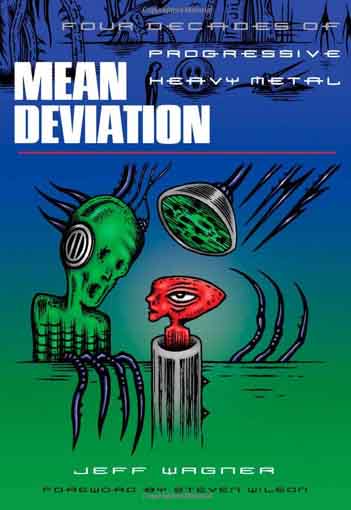 Human progress will forever be linked to those most primal memories of our species, wherein there emerged that intrepid curiosity that formed the crux on which history could be built. Moreso than the will to merely survive and subsist, it was the will to forsake the paradise of safety and pursue instead the harsh, untamed dusklands of the unknown, where intense tribulation could reveal the fiercest potentials of the few that could overcome. Within the realm of music — that most iconically Romantic of arts — this sentiment persists as a striving to expand the capacities of willful expression into an all-encompassing whole, swelling into symphonic full bloom during the 19th Century. But now, in the dreary modernity that constitutes post-World War II planet Earth, Metal music has proven to be an improbable successor to this upward-climbing composing ethos, and its 40-year history itself resembles less some linear development than it does the genealogy of a warrior race: evolving as one from troglodytic Rock origins, but then splintering into variegate subdivisions as established kingdoms become ever stiflingly overpopulated. If it is those most radical of subdivisions commanded by wildcat eccentrics, hermitic technicians, and sadistic savants that best define the nebulous label that is “progressive metal”, then ‘Mean Deviation‘ — the new and exotic pet project of Metal Maniacs veteran Jeff Wagner — is the one book ambitious enough to fasten a historical yoke around such a chaotically polymorphous Metal strain.
Human progress will forever be linked to those most primal memories of our species, wherein there emerged that intrepid curiosity that formed the crux on which history could be built. Moreso than the will to merely survive and subsist, it was the will to forsake the paradise of safety and pursue instead the harsh, untamed dusklands of the unknown, where intense tribulation could reveal the fiercest potentials of the few that could overcome. Within the realm of music — that most iconically Romantic of arts — this sentiment persists as a striving to expand the capacities of willful expression into an all-encompassing whole, swelling into symphonic full bloom during the 19th Century. But now, in the dreary modernity that constitutes post-World War II planet Earth, Metal music has proven to be an improbable successor to this upward-climbing composing ethos, and its 40-year history itself resembles less some linear development than it does the genealogy of a warrior race: evolving as one from troglodytic Rock origins, but then splintering into variegate subdivisions as established kingdoms become ever stiflingly overpopulated. If it is those most radical of subdivisions commanded by wildcat eccentrics, hermitic technicians, and sadistic savants that best define the nebulous label that is “progressive metal”, then ‘Mean Deviation‘ — the new and exotic pet project of Metal Maniacs veteran Jeff Wagner — is the one book ambitious enough to fasten a historical yoke around such a chaotically polymorphous Metal strain.
It’s a ridiculously exacting task to try and chronicle the entirety of a musical subgenre that isn’t really a subgenre, and whose content cannot be readily identified by formal analysis alone. And yet Wagner, being the dauntless historian that he is, enters the Nocturnus Time Machine® with naught but the earnest objective of highlighting whichever works were exceptionally bizarre, brainy, or both. Placing his starting coordinates in the late 1960′s when progressive rock and early ambient music had already begun to explore more neoclassical avenues, Wagner narrates the concomitant emergence of heavy metal, and oversees its unprecedentedly rapid appropriation of prog complexities. The most non-canonical, wildly erratic career choices of Black Sabbath, King Crimson, and especially Rush receive extensive coverage, and upon this foundation of classic radio giants, Wagner uncovers many of the grandiose intellectual motivations that would plant the seeds of ambition in the burgeoning ’80s underground — an explosive era that Wagner veritably lived and breathed throughout.
From this point is of course where the bulk of the book begins and where divergent paths are most numerous and dramatic, starting with an initial divide between what is now commonly known as Progressive Metal proper — Fates Warning, Queensrÿche, Crimson Glory, and [must we mention them?] Dream Theater as examples — and the more abrasively progressive styles that were set in motion by speed metal aberrants Watchtower, Voivod, Celtic Frost, Coroner, and a small conglomerate of other leaders whose names consistently haunt the chapters further on. The subsequent outgrowth of extreme metal within the following decade then takes the spotlight for what seems like a third of the book, and the magnitude of its proliferation logically finds Wagner having to document deviance on a steady, region-by-region basis. But in this manner, he is as remarkably thorough in his examinations of familiar prog-extremists as he is with some of the more impossibly obscure names, reliably identifying which recordings showed noteworthy marks of ingenuity. A study of Finland, for instance, seizes Demilich by the tentacles and takes special interest in Beherit‘s darkwave transmogrification. Norway’s chapter highlights Mayhem‘s early adoration of Swedish prog band Änglagård and of course German synthpop and kosmische musik, and goes on to investigate the growth of Manes, Burzum, Enslaved, and Neptune Towers. Continental Europe reveals a constellation of luminaries ranging from Supuration to Atrocity, whilst the melting pot frontiers of the Americas yield regional anomalies as diverse as Gorguts and Obliveon up in Québec to Atheist and Hellwitch down in Florida. And, wherever possible, Wagner takes great efforts to cite any intellectual influences or achievements on the bands’ parts; tellingly, Classical and ambient music is a frequent subject here, as are academic degrees in a surprising array of fields.

It is surely impossible to write a “progressive metal” book that will be accepted in all circles of the culture, as controversy and even widespread disapprobation seem to be taken for granted in the music itself. But for the particular minority who identify themselves as hessians, it is certain that many will lose interest as the final hundred pages close in, simply because almost all of the so-called cutting edge Metal bands of the late ’90s and onwards fail to contribute anything significant to the genre; but in Wagner’s defense, there are many instances where he does bring attention to the growing problem of entropy. The more philosophical among us may further object to the very grounds for Wagner’s criteria for “progressive-ness” — that is, how much the work in question defies convention and expectations. To build from an early example, Wagner argues that Voivod’s ‘Angel Rat‘ — an album widely lambasted as a sell-out for its regression to verse-chorus, consonant indie stylings — is in fact a progressive step for the band because it was so utterly unlike any of the albums that preceded, or anything else in the scene at the time. But this is nothing if not the most prostrate kind of optimism, which accepts an undesirable antithesis — in this case, total artistic decline into meaninglessness — as a necessary part of a dubious process towards some ideal of absolute artistic freedom or whatever. It’s true that to speak of “progress” we need to postulate an objective or end of some sort to move towards, but externalities like novelty and individuality alone are insufficient; something more intrinsic to Metal’s being must be identified, otherwise you allow for a flood of the same self-obsessed, irrelevant music-as-product to garner the association simply because it’s clever enough to imitate the distorted aesthetic. Therefore it is best to assert as an axiom that for the subject to be Metal, it must have as its essence that visceral if rather elusive-to-define spirit of vir, whose amorally creative will to power is partially outlined in the introduction to this review. From here, determining progression in Metal is only a contextual (and decidedly more limited) matter of whether the subject meaningfully transmits its central motivation using methods previously unexplored, for any number of nuanced reasons ranging from technical breakthroughs to conceptual maturation to ingenious angles of arrangement; of course, the ironic consequence to progressive forms is that they are often seized upon by the majority and ossified into standard forms over time. So, based on these tenets, you would have to re-evaluate progressive-labelled, impostor Metal bands like Opeth as actually not effectively progressive as a band like Morbid Angel, who were significant not only for innovative technique, but for using their talents towards representing death metal philosophy with hitherto unheard-of imagination and perspicuity. Take this same critical hammer to the “progressive eras” of Enslaved, Amorphis, Death, and all related corrupted prodigies who allowed themselves to be domesticated into entertainers, and suddenly ‘Mean Deviation’ is chiseled down from a bloated tome to a slim pamphlet.
 Now it’s apparent that ‘Mean Deviation’ surely has its points of contention, but then again the book’s stated aim isn’t to illustrate a concrete and ontologically-sound definition of what progressive metal is, nor is it out to namedrop every single band that may have garnered the label through whatever happenstances of popular delusion. Essentially, the book’s aim really is as simple as what its title conveys: to reevaluate the Metal timeline with a specific interest in whatever was outstandingly highbrow and/or shunned by the hypothetical average headbanger. It is a scholarly, well-referenced, yet personable inquiry of metallurgical innovation, which harbors aspirations towards objectivity and acceptance amongst society’s intellectual elite, but never mistakenly reduces the art to a mere science. Rest assured that trivia in abundance is here to tantalize the reader’s inner nerd; just remember to take it all in with a sizable grain of sodium chloride.
Now it’s apparent that ‘Mean Deviation’ surely has its points of contention, but then again the book’s stated aim isn’t to illustrate a concrete and ontologically-sound definition of what progressive metal is, nor is it out to namedrop every single band that may have garnered the label through whatever happenstances of popular delusion. Essentially, the book’s aim really is as simple as what its title conveys: to reevaluate the Metal timeline with a specific interest in whatever was outstandingly highbrow and/or shunned by the hypothetical average headbanger. It is a scholarly, well-referenced, yet personable inquiry of metallurgical innovation, which harbors aspirations towards objectivity and acceptance amongst society’s intellectual elite, but never mistakenly reduces the art to a mere science. Rest assured that trivia in abundance is here to tantalize the reader’s inner nerd; just remember to take it all in with a sizable grain of sodium chloride.
Written by Thanatotron
1 CommentTags: zine-books
When the stars are right, when the planets of alien coordinates align in perfect syzygy, when the arcane progress of dark matter warps the cosmos into gravitations of sinister consequence, the Dead Gods may once again rise from their eonian slumber… but only if the proper rites are set in motion by those giftedly prescient of mortals. Chainsaw Abortion-ist Brian Pattison was one such a prophet who had succeeded before in the act: 1990′s Day of Death, an atrocity survived by none but a fanatical few, and the tale obscurely recounted within the scripture known as Glorious Times. Now 21 earth-years after that most notorious of receptions in the death metal saga, a wiser but no less maniacal Pattison determined the time was ripe for another extra-dimensional conjuration, with no less a death-god than Kam Lee in mind as his ultimate summoned entity. Naturally, the Buffalo territory of New York would again provide the setting, with the chosen temple for this installment being the rather profoundly-named Club Infinity.
An unprecedentedly cavernous venue, Club Infinity can house up to 500 or so bacchants before it becomes a legal deathtrap — yet attendance for the day must have been less than half of that numeral. Apparently, the local Buffalonians who would normally haunt the premises for their fix of alcohol and loud noises had absconded to a different corner of the land, lured up and away by the promise of an outdoor barbeque/live music festival of some sort. As it were, only the blackest-hearted diehards heeded the call to this cursed slice of suburbia, where memories from beyond time would once again climax in a lurid celebration of the horrific, the macabre, the rapacious and warfaring facets of existence from which fleeting mortality truly derives its meaning. Our lives — and indeed our deaths — would bear the distinct and indelible imprint of this Day as a scar that never heals, and whose free-flowing ichor blazes a sanguinary trail across ages…
Lethal Aggression: New Jersey’s crossover-thrash godfathers themselves had been the honorary headliners for the pre-Day of Death celebration, which of course had been successfully realized the previous Friday night; but for Saturday’s Day of Death proper, Lethal Aggression actually re-emerged from their dens — bleary-eyed and wracked with raging katzenjammer — at an ungodly brunch hour to be the very-fucking-first band in the proceedings, which was a display of tenacity mostly lost on the scant gathering of earlybirds. What followed was a forthright little blitzkrieg of their trademarked “drugcore” anti-anthems, which was made all the more special for the occasion with the return of classic-era guitarist Dave Gutierrez (though he may have been initially unrecognizable due to his new blue-dyed and bespiked hair), who additionally was commendable for drawing the wicked Lovecraft-inspired design for the Day of Death T-shirts. Towards the end of their timeslot, though, it became clear that vocalist John Saltz had most anticipated getting to the last song on the list — “No Scene” — as he had accidently launched into that whole vocal line during the beginning of penultimate song “Spooge”, causing the band to screech to a stop and start all over. In retrospect, the mixup should not have been too surprising, as the apathy-decrying, poseur-scourging lyric matter (the key verse being, “All you do is come to shows, sit around and stare”) was uncomfortably relevant enough to boil our blood. And this was an absolutely necessary kick-in-the-ass to start everything off on the right track.
Hubris: Being the first of four local bands to open up a 13-band procession is a task about as unpleasant as serving in the infantry during a foray into an uphill battle, and yet the cadre known as Hubris still mobilized for their set like the hungriest of mercenaries — corpse paint, wicked demeanors and all. Though they are a relatively new constellation in our Northern skies (to wit, all of their embryonic recordings thus far feature a drum machine because they could not, until recently, secure a faithful skinsman) Hubris’ style of black metal extrapolates directly from the most abrasive entries in the classical Scandinavian school, falling into a nebulous scape between Marduk’s Opus Nocturne and Immortal during their soulraping halcyon years with Demonaz. But at 4 p.m. in a sun-baked, poorly ventilated enclosure, the band’s blizzarding invocations of carnage-strewn battlefields and holocausted settlements were all but guaranteed to a tepid reception. Frontman Hellskald vehemently refused to let the standers-by off easily, however, and at numerous intervals demanded choruses of quasi-fascistic fistpumping from every slouched, beer-nursing figure in the near and far vicinity. It would be difficult to not be impressed by the young band’s charisma, and Hellskald’s exiting exhortation to “Rape angels! Drink their blood! Castrate God!” would basically set the tone for the remainder of the rituals to follow.
Seplophile: Attribute it to that everflowing stream of youthful vigor if you will, if that would most efficiently explain how Seplophile had the mettle to burn through one of their own setfuls of brutal death, just a few hours before they would entirely re-animate the godlike monolith of morbidity ‘From Beyond’ with living legend Kam Lee. Despite Seplophile’s ostensible “newcomer” status, they are a band that follows “The Old School Spirit” as their unshifting lodestar, and their drive is incited by memories of the vital role that the Buffalo scene had once taken in the death metal genesis (that is, before everyone and their grandparents emigrated to Florida). Their discography to date apparently features none but a single demo ‘…And Death Shall Have His Dominion’, so the boys did not exactly have a hell of a lot of material to choose over, but their formulas exhibit a certain potency of form and execution that echoes the advanced blastations formerly mastered by the early incarnations of Cannibal Corpse and Cryptopsy. If anything, the set was a reassurance that this fledgling local band had talent in abundance for the daunting role of Kam Lee’s backing band, and that would only further whet our bloodlusts for the Massacre to come.
Resist Control: Reportedly one of the all-time favorite newer Buffalonian bands of Brian Pattison himself, Resist Control followed swiftly on Seplophile’s heels with high-octane, classic hardcore-thrash madness that veers more towards the vehicle of purposeful, distinct narrative rather than uncontrolled paroxysms of angered words and misplaced epithets. This is the type of band that would incite violent, all-consuming pits amongst any gathering of punks and skins on a normal night, but of course since Resist Control were haplessly saddled on the first quarter of a 12-hour-long engagement, they were mostly just gawked at by those who weren’t caught up at the bar or the merchandise tables with all the luminous death metal celebrities. Still, the band gave voice to outrage as sonorously as a good “canary in a coalmine” ought, and it would be well-off if they could soon branch forth from their hometown Buffalo circuit and reach more disenchanted ears out in the rest of the Amerikan wasteland.
Sam Biles: Caught in similar circumstances with antihero-of-the-day Kam Lee, Sam Biles is an illustrious frontman who for some reason or other stands separated from his classic backing band — Hideous Mangleus, in this case — and so performed his best-loved songs at Day of Death eponymously, with the aid of youthful and capable hired hands. Somehow, Biles had managed to secure and implausibly import a star-crossed trio of Texan luminaries to stand in as his henchmen: on guitar, Francisco of HRA; on bass, Dave of PLF; and on the drumthrone, Matt of Blaspherian. This ad-hoc convocation had actually never before rehearsed with Biles, and yet their set for the evening came together with such natural beauty that a blind man would no less envision the old gang of Feev and the Brothers Bonde back at their respective spots (except — dare we say it — with tighter musicianship?). Preposterously outfitted with all of cast-iron armbands, leather pants and a fucking Ratt T-shirt, Biles prowled the peripheries of the stage like a caged beast whilst animating every disturbingly hilarious lyric with guttural prowess — and of course, the Tejas Squadron behind him did not once skip a stroke, faithfully re-enacting the catchiest death-throes behind material like “Question Your Motives” and “Burning Children” (“Remember kids, don’t play with matches! Aaaaaargh!“). If the audience gathered for the night had any doubts about Biles’ solo appearance, their apprehensions were completely quashed before the first song even ended; and by way of analogy, it could be correctly assumed that Kam Lee wouldn’t need Rick Rozz, Terry Butler or Bill Andrews to pull off the old Massacre songs with masterful [dis]grace.
Avulsion: The final of the local marauders to be showcased for the Day, Avulsion are elder guardians (est. ’92) of the Buffalo death metal tradition, though their essence is thoroughly imbued with eclectic dosages of hardcore and grind. Shrewdly tongue-in-cheek yet convicted in their anti-humanist manifestos, this band effectively mimics the torments of alienation through truncated songs patched together from ambiguously buzzing tremolo riffs. But perhaps their most distinctive asset is the uncanny throat-power of their frontman, who is able to switch so rapidly between a strident punk shout and a rattling growl that it was easy to be fooled into believing there was more than one lead vocalist at work. After completing a formidable listing of original compositions in record time, Avulsion thought well enough to conclude their set with a cover of Carcass’ “Empathological Necroticism”, which certainly tweaked the ears of all those yakkers in the vicinity who were only half-listening otherwise.
Goatcraft: The horned and cloven-hooved brainchild of keyboardist Jason “Lonegoat” Kiss, Goatcraft is purest piano metal unbounded from the conventional backdrop of screaming strings and timekeeping clangor, essentially comprising foreshortened sonatas that weave narratives and paint airs with bleak minimalism — obviously, this performance would be the one looked upon as the “oddball” on the bill by a large portion of the audience, if only for their bewilderment over aesthetics! Matters were not made much more agreeable due to the fact that The Lonegoat did not have access to his personal keyboard for the night, and thus had to make do with a rented piece of junk that would hiss and sputter at loathsomely frequent intervals. Though the technical difficulties as well as the piss-drunken interjections of certain audiencemembers shot through any semblance of good ambiance for this listening session, the one-man-band remained steadfastly transfixed at his post, only uttering a few words of exposition when necessary, or still more rarely betraying a glare from beneath a heavily corpsepainted and bloodsoaked brow. It may be a sad inevitability that those few ambitious souls who elect to play solo, ambient Metal in a concert setting will never have the right kind of audience, as people who walk the hessian path between Classical and Metal appreciations are still unmercifully uncommon, especially in regards to the U.S front. But for any matter, Goatcraft is still a promising work in progress; expect to hear more from this satyrid maestro in further compositions both personal and collaborative.
Druid Lord: The newest creative vehicle of former Acheron axemen Tony Blakk and Pete Slate, as well as their skin-hammering Equinox comrade Stephen Spillers, Druid Lord is a death/doom affair that draws its most prominent tributaries from the sludge-tainted fountainheads of Winter’s Into Darkness and Autopsy’s Mental Funeral, with perhaps the faintest hints of vintage Cathedral coursing noxiously through the solution. But whatever feeble combinations of band names one chooses for describing Druid Lord, it remains that this band gathers its purpose in delineating true imageries and sensations of Horror: the same inspiration for all music branching from the germinal genius of Black Sabbath. For their Day of Death appearance, Druid Lord had driven up north nonstop from their vantage point in the opposite pole of the country (Orlando, Florida), which might have added an honest dimension of bodily-excruciation to their already torturous live show. Though their 2010 LP Hymns for the Wicked lists Druid Lord as being a three-piece, they have since added Ben Ross as a rhythm guitarist, allowing The Great Slate to solo to his evil heart’s content whilst dense riffing frequencies are maintained. Bassist/vocalist Tony Blakk, already bedecked with plenty of frontman’s credentials for his years in Equinox, was practically thespian here in his snarled descantations of grisly fates. But for the song “All Hallows Evil”, he stepped aside to allow Kam Lee to take over on vocals — a very honorary guest appearance that would only be shared for the night by Derketa. Speaking of which…
Derketa: As of late, reunions in classic death metal have occurred on such a frequent scale that even the over-sanguine among us are becoming rather desensitized; an entity like Derketa, however, is so improbable a phoenix to rise from the ash that only the ignorant could fail to take notice. Formulated in the foundational ’80s era by Sharon Bascovsky and Terri Heggen, Derketa holds historical leverage alone for being the first female death metal band; of course, they earned their musical leverage by their demo recordings and the ‘Premature Burial’ EP, which featured decelerated-tempo, incredibly growly songs that sounded somewhere deep within the realms of Hellhammer and Nihilist. But the immediate intrigue that the band’s output garnered seemed to cause the very pressure that broke them apart, although Bascovsky put forth several honest attempts to keep Derketa’s name alive over the years, finally succeeding in a full reunion by 2006. Only five years later did the revitalized cult feel strong enough to begin live outings: the first three in their native Pittsburgh, and the forth to be Buffalo’s Day of Death 2011 — significantly, the girls (minus current bassist Robin Mazen, who was busy with Demonomacy back in Florida) had been in the audience for the fest’s 1990 edition. When it was finally time for Derketa to commence with their first out-of-state appearance and the opening sequence for “Premature Burial” was sounded, practically the whole fan-populace in the venue came flying to crush in front of the stage. Guitars sounded appropriately huge and menacing (although in the beginning only Sharon and Robin could be heard, as Mary Bielich’s distortion pedal had shorted out), and it’s apparent that over the years Sharon has trained her vocals to be even more fearsome. It was especially uplifting, though, to see Terri reprise her role as the original female death metal drummer — still the rarissimus avis of the genre — and as she was able to borrow Rottrevore’s massive drum kit, her blows were as sonorous as they could be. A brand new song called “Rest in Peace” (dedicated to Seth Putnam and others in a growing list of “dead metal guys”) was showcased: it could be the most doom-influenced track they’ve composed yet, which probably hints a lot at the overall aesthetic to expect on the imminent debut LP, In Death We Meet. And, as mentioned before, Kam Lee made one more guest appearance for the song ‘Last Rites’, growling along with his brightest female disciple for what must have been a very high point in the band’s lifespan.
Rottrevore: After Derketa and Sam Biles-technically-Hideous Mangleus, Rottrevore were the last in a series of revitalized Pennsylvanian cults to preside over Day of Death with their characteristically Northeastern, bowel-wrenching odes to the evil in man. Known best amongst the underground for their solitary full-length opus Iniquitous — an onerous, eldritch epitaph crafted after the most primeval echoes of the Stockholm and New York schools — the band almost inexplicably vanished from the scene shortly after the release, issuing no signs whatsoever from under their official banner save for the ‘Disembodied’ compilation pressed by Necroharmonic some time ago. This being so, their sudden resurgence back into action this year — signing with Spain’s Xtreem Music, dusting off unreleased songs, logging studio time with Erik Rutan for a new EP — is more than remarkable, and Day of Death would be honored with the first Rottrevore performance in nearly two decades. Frontman Chris Weber did not at all contrive much fanfare and flamboyance about the distinction, however, and preferred to be businesslike in his dispensation of aural punishment. Their set of course included all the choicest bits from Iniquitous (this humble narrator was partial to ‘Unanimous Approval’ and ‘Incompetent Secondary’, but everything honestly sounded true-to-form), and there was also a peppering of the new material which sounded to be very close in spirit to the classics, which is a very good thing indeed. This reunion show turned out to be a success in any respect, and the fact that it was all only a preview of what is to come can only confer the best of prospects.
Deceased: Who could have imagined that our most beloved Virginian bizarro-deathmeisters Deceased would be the only holdovers from the first incarnation of Day of Death? Granted, in the 21 years that have elapsed since then, the band has metamorphosed into an almost entirely different beast: the latest album Surreal Overdose features a tightly-crafted continuation of the ripping speed metal that has become their standard since the mid-’90s; and of course, King Fowley now vocalizes at the helm rather than behind the drumkit, backed by a quartet of mostly drafted-for-the-live-show mercenaries (including, for the very first time, guitarist Danzo of New York City-area hilaritythrashers Vermefüg). With a varied listing of the old savage classics mingled with everything up to the newborn creations, Deceased had a canonical time-travelling drama to offer their audience, although their stage time had to be disconcertedly hurried along due to some fascist schedule-policing on the venue’s part. This constraint was especially bogus for a born raconteur like King, who barely had an adequate moment to address his audience between songs, yet he still strived for those full Deceased theatrics we’ve all come to expect, complete with fucked-up monster masks and all such related tomfoolery. Perhaps, in recognition of the spirit of Day of Death, Deceased should have traded out some of their later-period songs for more selections off the early milestone ‘Luck of the Corpse’ and so on, since the audience was uniformly comprised of old-school hessians hellbent on tradition. But whatever the case, it was gratifying to have one of the original fest participants return for the second incarnation — and how many bands other than Deceased truly demonstrate the longevity of the underground death metal practice?
Insanity: It would not at all be a droll exaggeration to nominate San Francisco’s Insanity as the least fortunate band in all of death metal, following from their absurdly tragical biography as the one-time most promising vanguards of the newly developing extreme style, poised at the very cusp of self-realization yet cruelly denied their seat in the pantheon due to terminal illnesses, crippling accidents, and the ever shifting sands of label-backed patronage. Fate is a bitch, as superhumanly tenacious frontman Dave Gorsuch knows only so well at this point, and Her cantankerous whims sure enough wrought hell on Insanity’s maiden voyage across the Northeast. The very first tour date in Toronto had to be cancelled due to issues with bordercrossing policies, and during that same time bassist Falko Bolte was sniffed out for drug possession and was summarily locked away in a local jail, for as long as it would take for his sentence to be issued. Shaved down to a trio with no low-end support, Insanity nonetheless soldiered onward to Club Infinity intent on following through on the warpath they had carved. Guitarist Ivan Munguia took over Falko’s vocal duties on the spot, and both guitarists turned up the bass on their amplifiers with the hopes of plastering up the frequency gap in their wall of sound. It was evident then that failure was decisively averted once the opening strains of ‘Attack of the Archangels’ sounded out across the hall, electrifying the East Coastal audience who had before only dreamed of bearing witness to California’s most mythical entity. Since Insanity’s complex, many-riffed compositions emphasize guitar theatrics over everything else, the lack of Falko did not distract too much from the live reenactments, and the normally-silent Ivan’s backup growls turned out to be commendably feral, especially for the newer material which draws more than usual from call-and-response vocal forms. But the high point had to be marked by the song “Fire Death Fate”, which might be declared the most well-known of all Insanity songs if mostly for the fact that Napalm Death did a cover of it on their ‘Leaders Not Followers’ tribute album: a rather late piece of evidence concerning the remarkably deep-rooted influence that Insanity exerted on British extreme metal. In all, Insanity’s appearance was laudable in spite of the hindrances that seem to perennially plague them, and your humble narrator would go on to follow the band for two more dates of the tour, which were similarly sublime beyond all belief and yet met with shockingly low turnout. But that, friends, is a story for another odd time and place…
Nokturnel: After Goatcraft and Sam Biles’ One-Off Backing Band, Nokturnel were the last of the fiends who flew up from Texas to play a set — although, most old-schoolers remember the band from when they were still based in their native New Jersey, rattling out an intriguingly odd permutation of Voivodian death-thrash on the oft-overlooked opus Nothing But Hatred (another lamentable victim of the doomstruck vessel that was JL America Records). But sadly, nothing at all from the back catalogue was to be on the menu for the night: Nokturnel were quite literally debuting a new drummer and it was simply not in their longterm interest to teach him anything other than their contemporary songs, which are structured and conceptualized out of a much different mindset than the ’90s fare. It was a let-down for the diehards — come to think of it, *everyone* who was gathered for Day of Death was essentially a diehard in some way (especially that magnificent bastard who adamantly demanded to hear “Nuke Seattle”: may you have Satan’s blessings) — but sets will be sets, and it was still fun to watch Tom Stevens shred like a maniac (until his guitar strap came flying off its peg in the middle of everything). We were, however, treated to some completely new material: “Demonic Supremacy” and “Ancestral Calling”, the latter of which was astonishingly pulled off despite the drummer’s inexperience of ever rehearsing it. But at the end of it all, when Tom and the gang were packing it up, the restless energy in the room very palpably spiked to the critical mass: with Nokturnel down, the strike of the fatal hour was fast approaching with the grand finale…
Kam Lee/Seplophile: Primogenitor, mastermind, chieftain, elder god — in death metal, these honorary titles can only officially be coronated onto one Kam Lee. As vocalist for the overwhelmingly foundational bands Death and Massacre, it was Kam who devised the guttural vocal approach closest associated with the genre; and — as is only natural for a Samhain-born son — it was also Kam’s profound knowledge of literary and cinematic Horror, as well as the darker facets of world history that gave concept and soul to an artistic movement. Though his deathgrowls became the stuff of legend early on in the ’80s tapetrading network, his best known contribution is arguably the full-length Massacre album From Beyond, and the fact that this meisterwerk would be fully re-concerted for Day of Death [or should it have been called “Asscrack-of-Morning of Death” at this point?] imparted a dizzying sense of disbelief on the intimate, rabid crowd clinging in front of the stage. But indeed, it wasn’t a collective delusion: the familiar hearkening of “Dawn of Eternity” resonated true through us all, and surely enough Kam Lee stepped forth from the shadows, with Seplophile’s instrumentalists trailing close behind. Previously, Kam had worn a Bone Gnawer shirt for lounging around with his fans and peers off-stage, but for this set he switched to one bearing a “Herbert West: Reanimator” logo — of course, very appropriately referring to the film based on the Lovecraft novella of the same name, with its central theme of profligate science hideously inverting the laws behind life and death. What followed was a set that went by a true-to-album, track-by-track order of those nine anthems we all know better and love better than family; Kam’s live execution captured the full, terrifying intensity of the recordings of his youth, and his ribald yet quickwitted banter in between is always prime entertainment. All the while, the axemen of Seplophile darted to and fro across the stage like winged nightgaunts, and considering how the band had only three rehearsals with Kam to prepare for the night, their performance was almost too good to be true. When “Corpse Grinder” finally ground everything to a halt, Kam and the boys made a hasty exit… but everyone knew the slaughter couldn’t possibly be over yet! And in no time, of course, the spotlights flickered back on and Kam had indeed returned with a few bonuses in store. There was “Provoked Accurser” from the fabled single of the same name, a cover of Impetigo‘s “Boneyard”, a ridiculously fun cover of “Skulls” by the Misfits (which Kam introduced with a paean to punk’s crucial relation to death metal’s genealogy), and finally the ‘Inhuman Condition’ EP’s cover of Venom’s “Warhead” (similarly introduced with reverent words for the Newcastle trio, and how they were responsible for Kam’s fateful crossover from punkship to metaldom). Kam also took advantage of his stagetime to relate some news concerning future exploits: apparently, he has rekindled his alliance with veteran Massacre/Obituary guitarist Allen West, and the duo are in the midst of a scheme Kam has decided to name “Corpse Rot” — a portmanteau of the Massacre song “Corpse Grinder” and the Obituary song “Slowly We Rot”… naturally! And with that, the stars again shifted into benign coordinates and the glorious spell was broken, yet the harrowing tale would be scribed immortally within the Necronomicon of death metal’s saga. For this Day would surely be the last Day that Kam Lee would perform those classic Massacre songs live in concert, and those who missed it, have missed it for all eternity.
-Thanatotron-
No CommentsTags: American Death Metal, Brutal Death Metal, death metal, Death Metal Culture, Grindcore, Progressive Death Metal, Thrash
Gontyna Kry – Welowie
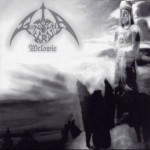
One of the best works of Polish black metal, Welowie has the craftmanship and melodic sophistication of Sacramentum’s best work but marginalizes the death metal influences, instead filling that loophole with the post-Discharge melodic hardcore that Graveland had a niche for carving out in their earlier work. Distant screams amidst a melancholic plethora of notational sequences reveal a sense of emotionally fraught catharsis not unlike a more musically ‘learned’ take on Mutiilation’s best works. The eight tracks on here run at just over 26 minutes in total but still in such a limited constraint manages to make the most of epic scope and artful expression within a time constraint that would more traditionally fit a death metal band. In some ways calling this work merely a ‘demo’ does it little justice. –Pearson
War Master – Chapel of the Apocalypse
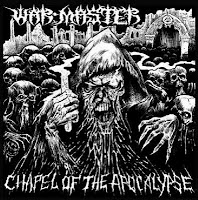
A young Texan war squad shows you don’t need advanced technique or labyrinthine compositions in order to succeed at pulverizing death metal hostility, as the palm muted chainsaw grind slugs onwards with the determination of a German panzer advancing towards certain death upon the Stalingrad plains. As with most young death metal bands, their earnestness sets them apart from most of the older colleagues and the primitive, architectural weight of “Awaken in Darkness” convinces one of morbid intentions unlike a thousand Necrophagists. Dark atmospherics abound in these documents of fear and rage in chthonic shade, bringing reminders of Amorphis’ and Incantation’s early Relapse days , the five musicians being able to build a solid tribute to their influences on this demo and generate a fiendish excitement for a capable followup. The success of the band in creating an esoteric sensation out of their simple source material is worthy of praise. –Devamitra
Witchblood – Witchblood
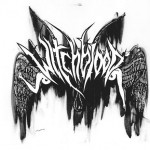
As if possessed by the ritual thrall of Walpurgis night, this mostly solitary creation of an individual called Iron Meggido is a clash of smoothly feline aggression of Nordic Black Metal with the Romantic architectural use of Heavy Metal riffs that characterized the occult metal of Celtic Frost, Samael and Therion. Alongside the suggestive and provocative riff stand the invoking voice of an Erinys caustically timed with the bludgeoning tempi of guest drummer L’Hiver. Underlying the beauty of this demo is the illuminated fire of an artistic vision in its birth-throes, painfully struggling against the bounds of convention in order to express the ultimately inexpressible: the twilight zone of fever and mythos where the ‘supernatural’ influences the evolution of man and mind. Hopefully their talisman is effective in order for the legion of Witchblood to fly even higher on these wings of rapture.
–Devamitra
No CommentsTags: Black Metal, death metal, Mythology, Occultism, War Metal